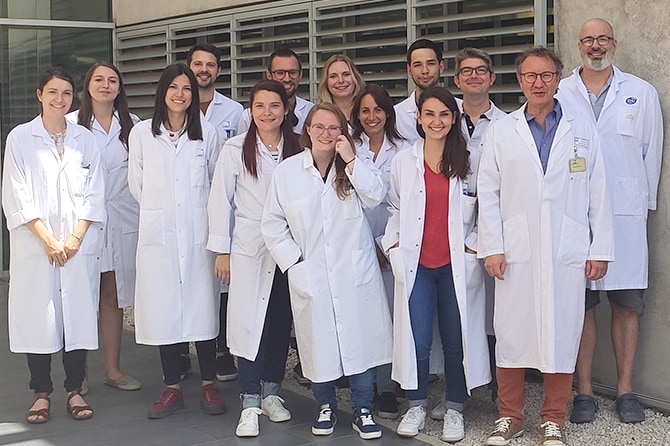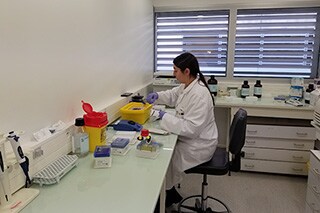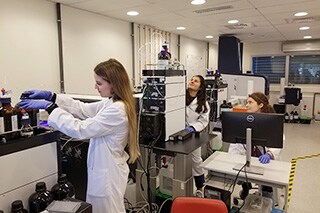Predicting Brain Diseases with Proteins


Shimadzu is working with scientists at the University of Montpellier to measure protein levels in the blood as predictors of Alzheimer’s disease, Parkinson’s disease and other age-related diseases of the brain years before patients show symptoms.
In the past 100 years, life expectancies across the world have doubled, and now anyone born in just about any country can expect to see their 60th birthday, something that was rarity a few generations ago.1 Cures for infectious diseases and treatments for what were once debilitating disorders are major reasons for this great change. At the same time, however, longer lives have left us exposed to new diseases, ones for which medicine can do little more than shrug. And of all those that come with age, perhaps none are feared more than diseases of the brain.
Indeed, 1 in 33 people 65-74 years old are expected to suffer from Alzheimer’s disease, a number that reaches 1 in 3 if over 85 years old.2 For Parkinson’s disease, the rates are less, but still the primary risk factor is age. Regardless, what defines these and other neurodegenerative diseases is the loss of brain cells.
Currently, medicine offers little in the way of treating neurodegenerative diseases. One reason is the late diagnosis, which makes intervention futile. By the time a diagnosis is made for Parkinson’s disease, for example, which is usually through visual symptoms, like the loss of motor control, the disease is usually well progressed, with around half the patient’s dopaminergic neurons already lost.3
Earlier detection then would expand the options of experimental drugs and other measures that are, if not curative, at least preventative and retard the degeneration. It is with this goal that the Shimadzu Corporation has teamed with Professor Christophe Hirtz of the University of Montpellier (https://ppc-montpellier.com/index.php/accueil-en/ ). The university itself is part of the Shimadzu European Innovation Center, which includes 12 institutes in 6 countries.

Professor Christophe Hirtz
“My story with Shimadzu started in 2015 at the American Society for Mass Spectrometry. I was contacted several times by Shimadzu France, who wanted to work with my lab in the field of clinical proteomics,” recalled Hirtz.“Shimadzu was not known in the clinical proteomics field when I started working with them. We did not know the quality of Shimadzu mass spectrometers.”
Clinical proteomics defines a subset of proteomics, or the study of proteins in an organism. While the Human Genome Project put a spotlight on the genes important for our health, it also revealed that proteins are arguably more important.4 Clinical proteomics identifies and analyses those proteins that have a clinical effect. For these experiments, a key resource in any research laboratory is mass spectrometers like the Shimadzu LCMS-8060 (https://www.shimadzu.com/an/products/liquid-chromatograph-mass-spectrometry/triple-quadrupole-lc-msms/lcms-8060/index.html).

Hirtz was eager to give Shimadzu a try, but he also did not have the funding to purchase a machine. He therefore proposed Shimadzu loan him a system with the promise to buy it if he was happy. Shimadzu was determined to work with one of the best in the field and made, as Hirtz recalls, an offer he could not refuse.
“You have the loan.”
“How long?”
“You keep it until can you buy it.”
Less than a year later, Hirtz did just that. He now has two LCMS-8060 and has a third on loan that he plans to buy.
“One of our goals is to identify key opinion leaders and form strong research relationships with them. We see partners, not customers. We work together to maximise their research and the performance of our analytical instruments,” explained Stephane Moreau, who is both the LCMS product manager at Shimadzu Europe and responsible for collaborations.
Neurodegenerative diseases are protein diseases
Neurodegenerative disorders are often characterized as proteinopathies, meaning brain cells accumulate abnormal amounts of specific proteins. Proteins come in many shapes, and even the same protein can take many forms, or proteoforms. The abundance of one proteoform or the ratio of different proteoforms in a cell is hypothesised to reflect a pathological state. For example, abnormal proteoforms of α-synuclein are commonly seen in Parkinson’s disease, but also in Lewy body dementia and multi-system atrophy, two other neurodegenerative diseases marked by different symptoms. However, the levels in a clinical sample can be very low, thus requiring mass spectrometry that achieves high sensitivity.
Shimadzu and Hirtz’s research team have been working together to detect pathological α-synuclein proteoforms in samples from more than 100 patients suffering from any of these three diseases. This effort follows other research from the lab that found through clinical proteomics that the proteoforms of multiple proteins may distinguish patients with Alzheimer’s disease, frontal temporal dementia, and dementia with Lewy bodies.5 More work by the Hirtz laboratory has found the benefit of clinical proteomics for using less invasive and therefore less painful diagnostic methods, which would expand the number of people willing to be tested before symptoms appear.6
“I can’t understand that in 2023, we plan to send people to Mars or the moon and we are still struggling in neurodegenerative disease diagnosis,” Hirtz said.
Hirtz stresses, however, that even with the sensitivity and robustness of the LCMS-8060, the work is much more than just turning on the machine and sticking in the sample.
“The hardest part is not the mass spectrometry. The hardest part is preparing the sample,” he observed.
That is because the proteins are extracted from complex cellular matrices taken from samples of plasma or cerebrospinal fluid. The Shimadzu partnership, therefore, is funding Ph.D. students to not only learn the mass spectrometry analysis, but also to optimise the biochemistry and workflow.
“Shimadzu has allowed me to expand my skillset in different domains. I have developed an expertise in neuroscience, biochemistry, mass spectrometry, proteomics and clinical research,” said Marie-Laure Pons, the first to receive such funding in the Hirtz laboratory. She expects to graduate this year.
Since that first encounter in 2015, Hirtz appreciates Shimadzu’s persistence to work together and says the partnership has gone well beyond his expectation, leading to a vital partner who offers much more than exceptional technology.
“The LCMS-8060 is one of the best triple quadrupoles on the market, [but] for me the collaboration with Shimadzu is based on trust and a long-term relationship. This is quite different from other companies. I must say that this is the most fruitful collaboration I have had and still have.”
* The information including affiliates and titles of the persons in this article are current as of the time of interviewing (December 2022).
* All the instruments in this article are research-use only (RUO) instruments and not for use in diagnostic procedures. Shimadzu is an analytical equipment provider and in certain regions, including the USA, Shimadzu products may be regulated as for research purposes only. If you have questions on approved use of a Shimadzu device, please contact your regional office.
1) https://ourworldindata.org/life-expectancy
2) DOI: 10.1002/alz.12068
3) DOI: 10.1007/s00702-018-1910-4
4) DOI: 10.1038/nmeth.2369
5) DOI: 10.1002/dad2.12285
6) DOI: 10.1007/s00702-022-02474-9
 Copied
Copied




